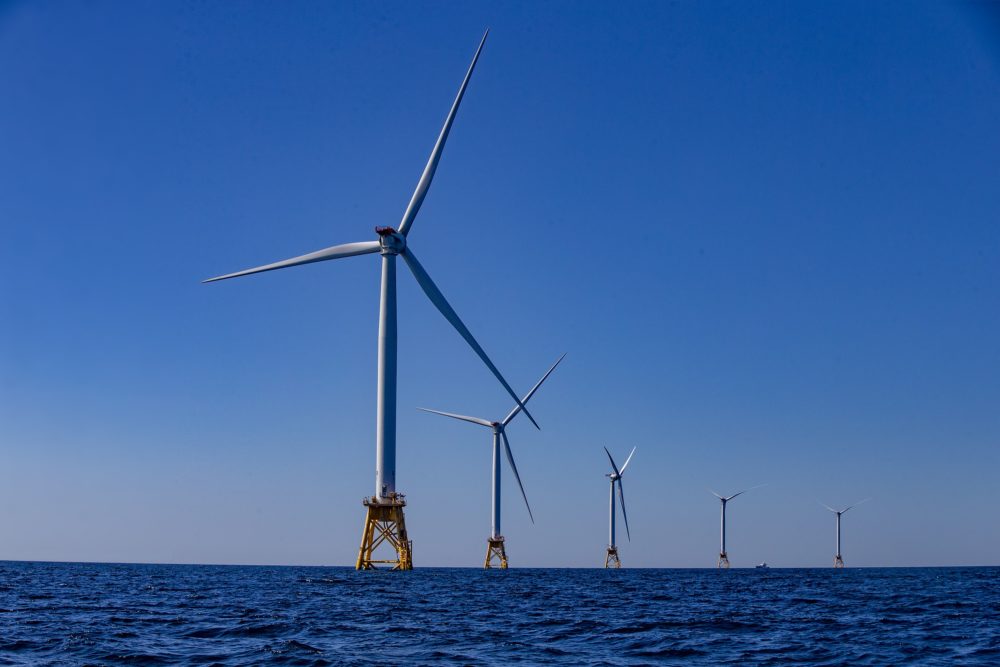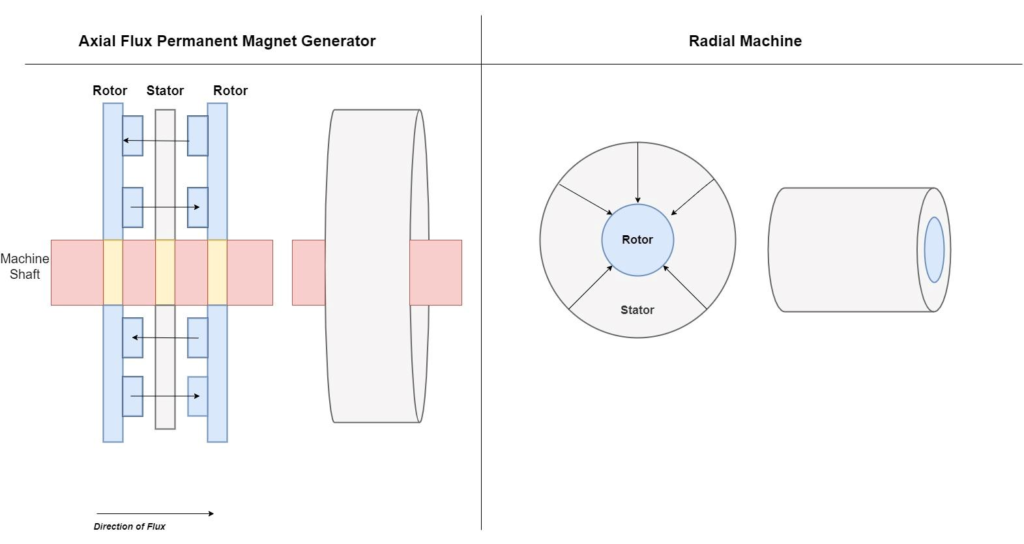I. Definition of Axial flux and radial flux permanent magnet generators
Axial flux permanent magnet generators (AFPMGs) are electrical generators that use a disc-shaped rotor with magnets mounted on their surface in a radial or axial direction. The stator is typically made up of a series of coils arranged in a circular pattern around the rotor, and the magnetic field generated by the rotating magnets induces an electrical current in the stator coils. AFPMGs are known for their high power density, compact size, and low weight, making them a popular choice for use in wind turbines, hydroelectric systems, and other renewable energy applications.

Radial flux permanent magnet generators are a type of electric generator that converts mechanical energy into electrical energy. They use permanent magnets mounted on a rotor to produce a magnetic field that interacts with a stationary set of coils to generate electricity. The flux lines of the magnetic field are directed radially outward from the center of the rotor, hence the name “radial flux”. These generators are commonly used in wind turbines, hydroelectric power plants, and other renewable energy applications. They are known for their high efficiency, compact size, and low maintenance requirements.
II. Axial Flux Permanent Magnet Generators
A. Design and working principle
Axial flux permanent magnet generators (AFPMGs) are a type of electrical generator that uses permanent magnets and a rotating magnetic field to produce electrical power. Unlike traditional generators, which use a radial flux design, AFPMGs have a unique design that allows for a more compact and efficient generator.
The basic design of an AFPMG consists of two sets of stator windings that are placed on opposite sides of a rotor. The rotor has a number of permanent magnets attached to it, which create a magnetic field that rotates around the axis of the rotor. As the rotor spins, the magnetic field passes over the stator windings, inducing an electrical current in the coils.
The working principle of an AFPMG is based on Faraday’s law of electromagnetic induction. When a conductor is moved through a magnetic field, a voltage is induced across the conductor. In an AFPMG, the rotor rotates the magnetic field past the stator windings, generating an electrical current in the coils.
The key advantage of an AFPMG is its compact size and high efficiency. The axial design allows for a more compact generator, which is ideal for applications where space is limited. Additionally, the use of permanent magnets eliminates the need for a separate excitation system, which further improves the efficiency of the generator.
AFPMGs are commonly used in wind turbines and other renewable energy systems, where they can convert the rotational energy of the wind or water into electrical power. They are also used in hybrid and electric vehicles, where they can generate electricity to power the vehicle’s electric motor or recharge the battery.
B. Advantages and disadvantages
Advantages :
1. High efficiency: Axial flux permanent magnet generators have high efficiency due to their low cogging torque and high power density.
2. Compact size: These generators have a compact size, which makes them ideal for small-scale applications.
3. Low maintenance: Due to the absence of brushes and commutators, these generators require low maintenance.
4. High reliability: Axial flux permanent magnet generators have high reliability due to their simple design and fewer moving parts.
5. Low noise: These generators produce less noise compared to other types of generators.
Disadvantages:
1. High cost: Axial flux permanent magnet generators are relatively expensive due to the use of rare earth magnets and advanced materials.
2. Limited power output: These generators have a limited power output, which makes them unsuitable for large-scale applications.
3. Limited availability: The availability of rare earth magnets used in these generators is limited.
4. Sensitivity to temperature: These generators are sensitive to temperature changes, which can affect their performance.
5. Difficult to repair: Due to their complex design, axial flux permanent magnet generators can be difficult to repair in case of a fault.
III. Radial Flux Permanent Magnet Generators
A. Design and working principle
Radial flux permanent magnet generators (RFPMG) are a type of electrical generator that uses the interaction between magnetic fields to convert mechanical energy into electrical energy. These generators have a unique design that allows for a high power-to-weight ratio and high efficiency.
The basic working principle of RFPMG involves the rotation of a rotor that is equipped with permanent magnets. When the rotor rotates, it creates a magnetic field that interacts with the stator, which is made up of a series of coils. As the magnetic field passes through the coils, it induces an electrical current to flow through them, generating electrical power.
The design of RFPMG is based on the radial orientation of the permanent magnets on the rotor. The magnets are arranged in a circular pattern around the rotor, with their north and south poles facing outward. The stator is positioned around the rotor, with the coils arranged in a radial pattern to match the orientation of the magnets.
When the rotor rotates, the magnetic field created by the permanent magnets passes through the coils on the stator, inducing an electrical current to flow through them. The electrical current generated by the coils is then collected through a set of brushes or slip rings and transferred to an external load, such as a battery or an electrical grid.
RFPMG are commonly used in renewable energy systems, such as wind turbines and hydroelectric power plants, where they can generate electrical power from the kinetic energy of wind or water. They are also used in small-scale applications, such as portable generators and electric bikes, due to their compact size and high efficiency.
B. Advantages and disadvantages
Advantages:
1. High efficiency: Radial flux permanent magnet generators have high efficiency due to the direct coupling of the rotor and stator. This eliminates the need for a gearbox, reducing energy losses and improving overall efficiency.
2. Low maintenance: The absence of brushes and slip rings in radial flux permanent magnet generators eliminates the need for regular maintenance.
3. High power density: The compact design of radial flux permanent magnet generators allows for high power density, making them suitable for use in small spaces.
4. Increased reliability: The direct coupling between the rotor and stator in radial flux permanent magnet generators makes them more reliable and reduces the risk of mechanical failure.
Disadvantages:
1. Cost: Radial flux permanent magnet generators are more expensive to manufacture than traditional generators due to the use of rare earth magnets.
2. Limited scalability: The size of the radial flux permanent magnet generator is limited due to the size of the magnets used. This makes it difficult to scale up for larger applications.
3. Temperature sensitivity: The performance of radial flux permanent magnet generators is sensitive to temperature changes, which can affect their efficiency.
4. Magnetic field strength: The strength of the magnetic field in radial flux permanent magnet generators decreases rapidly with distance, which can limit their effectiveness in certain applications.
IV. Comparison between Axial and Radial Flux Permanent Magnet Generators

Axial Flux Permanent Magnet Generators (AFPMG) and Radial Flux Permanent Magnet Generators (RFPMG) are two different types of generators used in various industries. The main difference between the two lies in the orientation of the magnetic field and the direction of the flow of the electromagnetic energy.
A. Efficiency: AFPMG generators are known for their high efficiency due to their compact design and the ability to generate power from both sides of the rotor. RFPMG generators, on the other hand, have a slightly lower efficiency due to the magnetic flux leakage at the ends of the rotor.
B. Power density: AFPMG generators have a higher power density due to their compact design and the ability to generate more power from a smaller footprint. RFPMG generators have a lower power density due to their larger size and the need for a larger air gap between the rotor and stator.
C. Cost: AFPMG generators are generally more expensive than RFPMG generators due to their complex manufacturing process and the use of high-quality materials. RFPMG generators are relatively cheaper due to their simpler design and the use of standard materials.
D. Application areas: AFPMG generators are commonly used in small-scale renewable energy systems, such as wind turbines and hydroelectric power plants. RFPMG generators are used in larger-scale power generation systems, such as gas turbines and diesel generators.
In summary, AFPMG generators are more efficient and have a higher power density, but are more expensive and commonly used in small-scale applications. RFPMG generators are less efficient, and have a lower power density, but are cheaper and commonly used in large-scale applications.
V. Implications for future research and development of permanent magnet generators.
1. Improving efficiency: One of the primary areas for future research and development of permanent magnet generators is to improve their efficiency. This can be achieved by reducing the losses in the generator, improving the design of the rotor and stator, and optimizing the magnetic field.
2. Increasing power density: Another area of focus for future research is to increase the power density of permanent magnet generators. This can be achieved by decreasing the size and weight of the generator while maintaining or increasing its power output.
3. Developing new materials: The development of new materials for use in permanent magnet generators is also an area of interest. Materials with higher magnetic properties, such as rare earth metals, can potentially increase the performance of the generator.
4. Enhancing durability: Durability is also an important consideration for permanent magnet generators. Future research can focus on developing materials and designs that can withstand harsh operating conditions, such as high temperatures and corrosive environments.
5. Integrating with renewable energy systems: As renewable energy sources such as wind and solar power become more prevalent, there is a need to integrate permanent magnet generators into these systems. Future research can focus on developing generators that can work efficiently with these renewable energy sources.
Overall, future research and development of permanent magnet generators will focus on improving their efficiency, increasing power density, developing new materials, enhancing durability, and integrating with renewable energy systems.